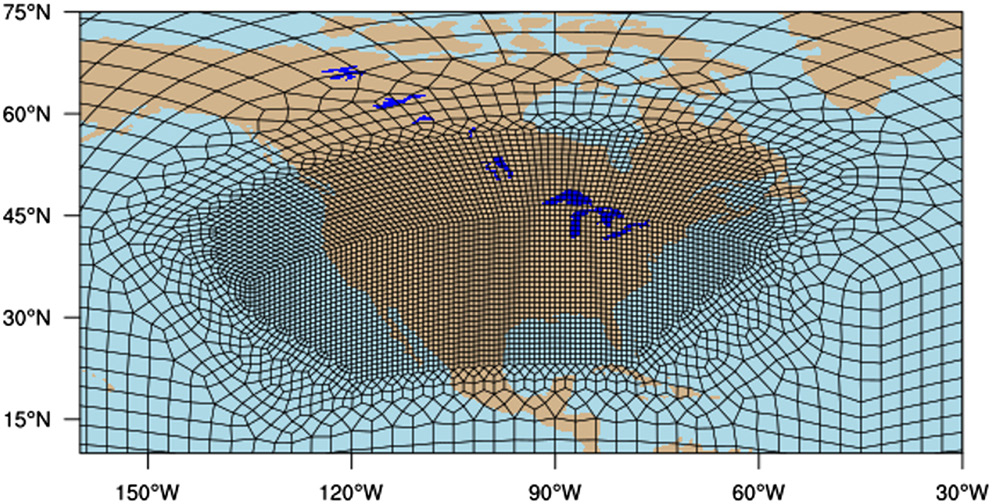New Cloud Microphysics Improves the Simulation of Mesoscale Convective Systems

An impressive mesoscale convective system over eastern Texas with a comma-shaped configuration. Image courtesy National Weather Service Weather Prediction Center | Twitter
Model bias in simulating mesoscale convective system precipitation can be reduced by a better representation of cloud microphysics.
The Science
Mesoscale convective systems (MCSs) play an important role in regulating global radiation and the hydrological cycle. However, global climate models (GCMs) have had problems simulating MCSs. Cloud microphysics can affect MCS organization (e.g., through latent heating, cold pool, etc.) and is one of the most poorly represented types of physics in GCMs. Researchers of recently published study (Wang et al 2021) found that improving the representations of cloud microphysics processes reduces model bias in simulating MCSs. Compared to the original microphysics scheme, the physically advanced ice microphysics in the new scheme improves the simulation of MCS precipitation and produces more realistic occurrences of heavy precipitation rates.
The Impact

Figure 1. A Regionally Refined Mesh (RRM) grid configuration for the atmosphere and land over the contiguous United States in EAMv1. The high-resolution area has a grid spacing of 0.25 deg, while the lower resolution area has a grid spacing of 1 deg.
These results provide a scientific justification for employing a more physical cloud microphysics scheme in future versions of the Energy Exascale Earth System Model (E3SM). The improved model performance demonstrates the importance of a realistic approximation of ice microphysical processes. As GCM resolution continues to increase, more convective processes and clouds will be resolved. The role of cloud microphysics will continue to be important for simulating MCSs.
Summary
Mesoscale convective systems are large storms that play an important role in regulating precipitation and climate globally. They are difficult to simulate in global climate models because of the inaccurate physics parameterizations and coarse resolution typical of GCMs. The regionally refined model (RRM) approach allows high-resolution regional simulations to be embedded in a coarse-resolution global model, enabling the simulation of MCSs. How models represent small-scale cloud microphysical processes affect their projections of MCS precipitation. A relatively new cloud microphysics scheme—Predicted Particle Properties (P3) scheme – has been modified and implemented into E3SM to overcome the limitations of the default Morrison and Gettelman (MG2) scheme in which rimed precipitating ice particles (graupel/ hail) are absent and frozen particles are artificially partitioned into cloud ice and snow.

Figure 2. Comparison of 2011 March-May accumulated total precipitation among (a) Stage IV observation, (b) the original E3SM scheme MG2, and (c) the new scheme P3. (d) Frequency distribution of hourly precipitation rates (d) – from observation (black), MG2 (blue), and P3 (red). P3 predicts more frequent occurrence of large rain rates than MG2, in better agreement with observations.
Researchers conducted RRM simulations at 0.25° over the contiguous United States using the new P3 scheme and compare the results with the original microphysics scheme, MG2. Scientists show that P3 improves the simulation of precipitation statistics including frequency distribution compared with MG2 with a limited effect on the diurnal cycle. P3 predicts higher hourly rain rates (Fig. 2), resulting in 20% more MCSs and a higher total MCS precipitation (4.4%) compared to MG2, agreeing better with observations. The improvements with P3 mainly result from improved representations of ice microphysics, which not only produces higher rain rates through melting but also leads to a stronger large-scale ascending motion by releasing more latent heating. This study suggests that improving microphysics parameterization is important for simulating MCS precipitation as future climate model resolutions continue to increase.
Publication
, , , , , , et al. (2021). Impact of a new cloud microphysics parameterization on the simulations of mesoscale convective systems in E3SM. Journal of Advances in Modeling Earth Systems, 13, e2021MS002628. https://doi.org/10.1029/2021MS002628
Funding
- The U.S. Department of Energy Office of Science, Biological and Environmental Research Program supported portions of this research as part of the Regional and Global Model Analysis (RGMA), Atmospheric System Research (ASR), and Earth System Model Development (ESMD) program areas.
- This research used resources of the National Energy Research Scientific Computing Center (NERSC).
- We acknowledge the support of the Climate Model Development and Validation program and the E3SM Science Focus Area. J.F. acknowledges the support of the Department of Energy (DOE) Early Career Research Program. Pacific Northwest National Laboratory is operated for DOE by Battelle Memorial Institute under Contract DE-AC05-76RL01830. Work at Lawrence Livermore National Laboratory (LLNL) was performed under the auspices of LLNL under contract No. DE-AC52-07NA27344.
Contact
- Jiwen Fan, Pacific Northwest National Laboratory
- L. Ruby Leung, Pacific Northwest National Laboratory
This article is a part of the E3SM “Floating Points” Newsletter, to read the full Newsletter check:


